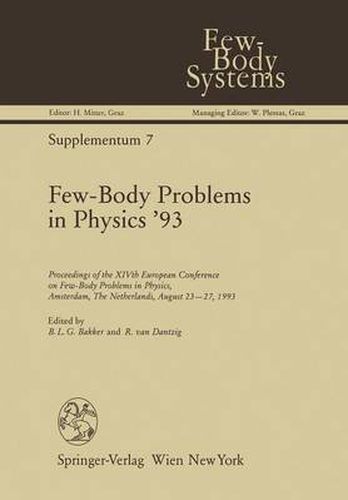Readings Newsletter
Become a Readings Member to make your shopping experience even easier.
Sign in or sign up for free!
You’re not far away from qualifying for FREE standard shipping within Australia
You’ve qualified for FREE standard shipping within Australia
The cart is loading…






This title is printed to order. This book may have been self-published. If so, we cannot guarantee the quality of the content. In the main most books will have gone through the editing process however some may not. We therefore suggest that you be aware of this before ordering this book. If in doubt check either the author or publisher’s details as we are unable to accept any returns unless they are faulty. Please contact us if you have any questions.
It is apparent from the history of science, that few-body problems have an interdis ciplinary character. Newton, after solving the two-body problem so brilliantly, tried his hand at the Sun-Earth-Moon system. Here he failed in two respects: neither was he able to compute the motion of the moon accurately, nor did he understand the reason for that. It took a long time to understand the fundamental importance of Newton’s failure, and only Poincare realised what was the fundamental difficulty in Newtons programme. Nowadays, the term deterministic chaos is associated with this problem. The deep insights of Poincare were neglected by the founding fathers of Quantum Physics. Thus history was repeated by Bohr and his students. After quantising the hydrogen atom, they soon found that the textbook case of a three-body problem in atomic physics, the 3He-atom, did not yield to the Bohr-Sommerfeld quantisation methods. Only these days do people realise what precisely were the difficulties connected to this semi classical way of treating quantum systems. Our field, as we know it today, began in principle in the early 1950’s, when Watson sketched the outlines of three-body scattering theory. Mathematical rigour was achieved by Faddeev and thereafter, at the beginning of the 1960’s, the quantum three-body prob lem, at least as far as short-range forces were concerned, w&s tamed. In the years that followed, through the work of others, who first applied Faddeev’s methods, but later added new techniques, the three-and four-body problems became fully housebroken.
$9.00 standard shipping within Australia
FREE standard shipping within Australia for orders over $100.00
Express & International shipping calculated at checkout
This title is printed to order. This book may have been self-published. If so, we cannot guarantee the quality of the content. In the main most books will have gone through the editing process however some may not. We therefore suggest that you be aware of this before ordering this book. If in doubt check either the author or publisher’s details as we are unable to accept any returns unless they are faulty. Please contact us if you have any questions.
It is apparent from the history of science, that few-body problems have an interdis ciplinary character. Newton, after solving the two-body problem so brilliantly, tried his hand at the Sun-Earth-Moon system. Here he failed in two respects: neither was he able to compute the motion of the moon accurately, nor did he understand the reason for that. It took a long time to understand the fundamental importance of Newton’s failure, and only Poincare realised what was the fundamental difficulty in Newtons programme. Nowadays, the term deterministic chaos is associated with this problem. The deep insights of Poincare were neglected by the founding fathers of Quantum Physics. Thus history was repeated by Bohr and his students. After quantising the hydrogen atom, they soon found that the textbook case of a three-body problem in atomic physics, the 3He-atom, did not yield to the Bohr-Sommerfeld quantisation methods. Only these days do people realise what precisely were the difficulties connected to this semi classical way of treating quantum systems. Our field, as we know it today, began in principle in the early 1950’s, when Watson sketched the outlines of three-body scattering theory. Mathematical rigour was achieved by Faddeev and thereafter, at the beginning of the 1960’s, the quantum three-body prob lem, at least as far as short-range forces were concerned, w&s tamed. In the years that followed, through the work of others, who first applied Faddeev’s methods, but later added new techniques, the three-and four-body problems became fully housebroken.